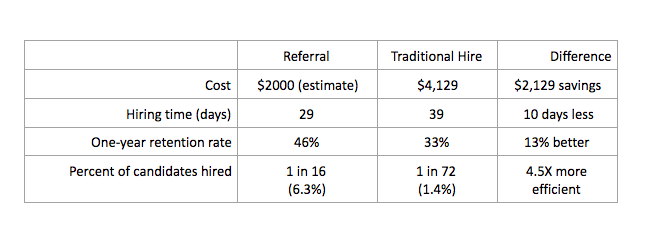3 Science-Backed Tips to Get More Out of Your Employee Referral Program

Employee referrals are a game-changer in the field of recruitment. What’s not to love about higher-quality candidates, lower cost per hire, reduced employee turnover, and bonus goodwill with your current employees?
And yet, while two-thirds of companies have referral programs, only 24 percent of employees are hired through referrals, according to a report from iCIMS. But that doesn’t mean employee referral programs are doomed to failure. Using the latest research in behavioral science, which studies how humans behave in certain situations, you can build a program that gets referrals falling into your lap like apples from a tree.
Why Do So Many Employee Referral Programs Fail?
The reasons can be many, but here are some of the most common ones:
- It’s too complicated. Your current employees have to jump through hoops to participate in the program, and running the whole show is pain in the you-know-what for the program administrator.
- It’s too risky. Your employees are wondering: “What if my referral doesn’t make it? What’s the damage to my reputation?”
- The reward is not commensurate with the effort required to refer a candidate. If you can’t show your employees the money, why would they show you the candidates they know?
- Referrals seem to fall into black holes after submission.Neither the referring employee nor referred candidate is ever informed about where they’re at in the process.
- No one knows about it! Do your employees even know your referral program exists?
Thanks to these issues, many referral programs lope along in the background, with hardly anyone paying attention. When successful referrals do happen, they’re interpreted as bonuses rather than as what the program is supposed to do.
Are Referral Programs Worth It?
Certainly! Consider that major players like Salesforce, Google, Accenture, Intel, and Godaddy all use referral programs as part of their recruitment processes. If that’s not enough to persuade you, consider a simple comparison:

(Sources: SHRM ; Jobvite ; ERE ; Lever )
Science to the Rescue
Want an employee referral program the delivers the kind of results you see in that chart? Here are a few simple, behavioral-science-based tips to help:
1. Make Referrals So Easy Your Employees Barely Have to Think About It
In Thinking, Fast and Slow, Princeton psychology professor emeritus Daniel Kahneman describes two thinking modes: System 1 is the brain’s automatic, unconscious thinking mode, while System 2 is slower and more analytical.
You want your referral process to steer clear of System 2. If your employees have to weigh the pros and cons, click through (or worse, print) a labyrinth of webpages, and submit a copy of their referral’s resume, they’re less inclined to ever send a referral at all.
Instead, referring a candidate should be as easy as sending a text message. Enter a little bit of info and click “send.” That’s it.
2. Match the Incentive to the Risk
Many employees are hesitant to provide referrals for fear that their recommendations won’t work out. Making a referral involves some amount of risk for an employee, and behavioral science tells us that the average person perceives loss to be twice as painful as a gain is pleasurable. Seen through this lens, the reputational loss that accompanies a failed referral may be far more impactful on an employee than a small monetary incentive (often $1,000 or less). That’s why studies find increasing financial incentives may not be enough to motivate more employees to share referrals.
A better option would be to help employees mitigate the weight of the risk in their minds. Ensure your referral program makes it clear that all candidates go through your standard hiring process and that their performance outcome is independent of the referring employee. Additionally, it can be helpful to offer more personalized incentives — or, at the very least, to provide referring employees with options. When people receive rewards they actually want, they’re more motivated to take action.
Don’t prolong the referring employee’s risk by having them wait to receive their incentive. If they give you a referral you end up hiring, pay them straight away. If the referred employee doesn’t make it past their probationary period, that’s on you and not the referring employee (after all, you made the call to hire the candidate).
3. Combat the Bias that Referral Programs Are Ineffective
Because so many referral programs really are ineffectual, your employees probably assume yours is no different. If your processes is complicated, you don’t communicate, and your incentives are misaligned, then you’re just confirming their bias that referrals are a waste of their time.
Give your employees every reason to question their bias by providing a smooth and transparent referral program. Take every opportunity to highlight and celebrate referring and referred employees to disrupt this bias further.
—
Employee referrals are one of the most reliable but underutilized methods of recruiting high-quality candidates. If you want to have any hope of attracting and retaining top talent, particularly in the post-pandemic era, you need to tap into the pipeline of talent your existing employees already know. Make it easy for them to help you, and they will.
Luke Sheppard is founder of Sheppard & Company and author ofDriving Great Results.

